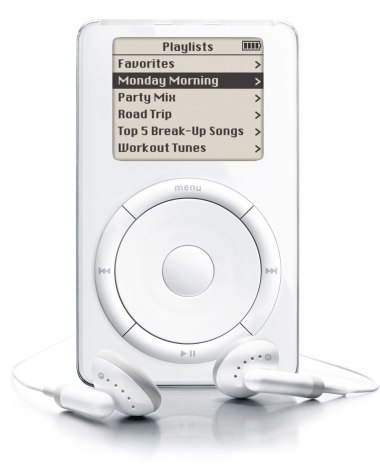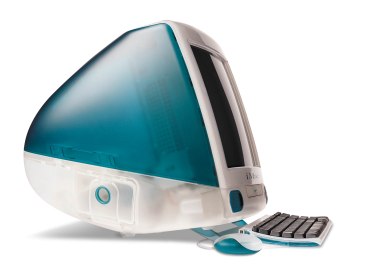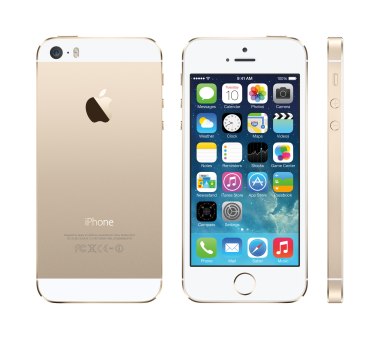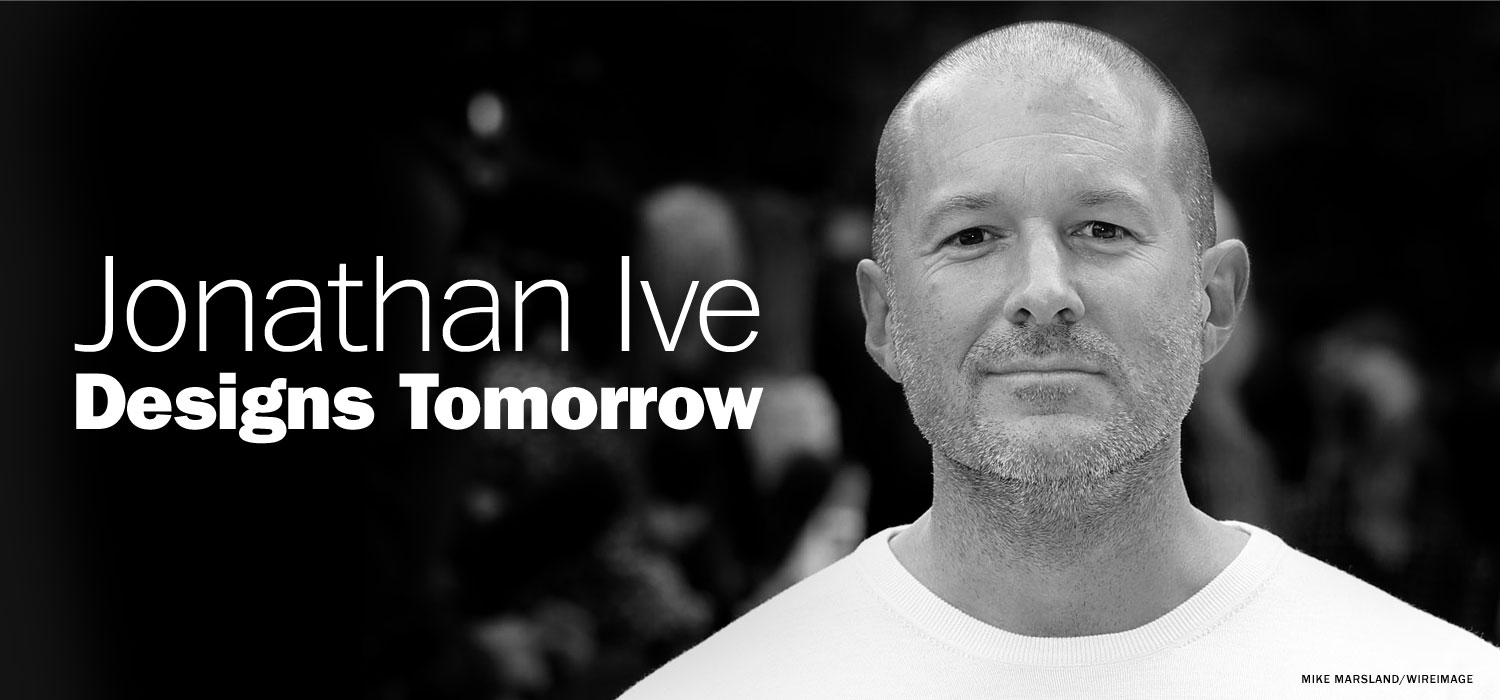We use Jonathan Ive’s products to help us to eat, drink and sleep, to work, travel, relax, read, listen and watch, to shop, chat, date and have sex. Many of us spend more time with his screens than with our families. Some of us like his screens more than our families. For years, Ive’s natural shyness, coupled with the secrecy bordering on paranoia of his employer, Apple, has meant we have known little about the man who shapes the future, with such innovations as the iMac, the iPod, the iPhone and the iPad. But last month, he invited me to Cupertino in Silicon Valley where Apple is based, for his first in-depth interview since he became head of design almost 20 years ago.
The gods — or was it the ghost of Steve Jobs? — seemed against it. Jobs didn’t like Apple execs doing interviews. It had not rained properly in California for months but that morning the clouds rolled off the Pacific, turning the Golden Gate Bridge black. Interstate 280 South to Silicon Valley was a river of water, instead of the usual lava streaks of stop-start SUVs. But just after 10AM, an Apple tech-head appeared in an all-white meeting room on the first floor of building 4 of the firm’s antiseptic headquarters with strict instructions to find an Earl Grey tea bag.
“Hello. Thanks for coming,” grins Ive, as he rolls in, picking up his brew. Ive is the most unremarkable remarkable person you could meet. You might think you’d recognize him if you passed him on the street, but you wouldn’t. He’s not particularly tall, is well built and bald(ish), has two-day-old stubble and dresses like dads do on weekends — navy polo shirt, canvas trousers, desert boots. He speaks slowly and softly in an Essex accent totally unaffected by living in America for more than two decades. “I can’t even bring myself to say math, instead of maths, so I say mathematics. I sound ridiculous,” he laughs.
Ive is in a good mood today — and not just because he’s celebrating his 47th birthday. He likes the idea of this interview series because he sees himself as more of a maker than a designer. “Objects and their manufacture are inseparable. You understand a product if you understand how it’s made,” he says. “I want to know what things are for, how they work, what they can or should be made of, before I even begin to think what they should look like. More and more people do. There is a resurgence of the idea of craft.”
Ive has been a maker ever since he could wield a screwdriver. He inherited his craftsman’s skills from his father, Michael. He was a silversmith who later became a lecturer in craft, design and technology at Middlesex Polytechnic. Ive spent his childhood taking apart the family’s worldly goods and trying to put them back together again. “Complete intrigue with the physical world starts by destroying it,” he says. Radios were easy, but “I remember taking an alarm clock to pieces and it was very difficult to reassemble it. I couldn’t get the mainspring rewound.” Thirty years later, he did the same to his iPhone one day. Just to prove he still could.
A love of making is something he shared with Jobs, Apple’s former chief executive who died three years ago. It helped the two men forge the most creative partnership modern capitalism has seen. In less than two decades, they transformed Apple from a near-bankrupt also-ran into the most valuable corporation on the planet, worth more than $665 billion.
“Steve and I spent months and months working on a part of a product that, often, nobody would ever see, nor realize was there,” Ive grins. Apple is notorious for making the insides of its machines look as good as the outside. “It didn’t make any difference functionally. We did it because we cared, because when you realize how well you can make something, falling short, whether seen or not, feels like failure.”
For a man whose products are all called iSomething, it’s surprising that “i” is one word Ive scarcely uses. He talks constantly about his team or Jobs, using “we.” This is not “aw-shucks” false modesty or corporate-speak. “I don’t like being singled out for attention. Designing, engineering and making these products requires large teams,” he says.
Ive really does keep a low profile — or at least as low a profile as you’d expect one of the world’s most highly paid designers to keep. He has only one house — in the swanky Pacific Heights district of San Francisco, where his neighbors include Oracle’s Larry Ellison, Paypal co-founder Peter Thiel and actor Nicolas Cage. He lives there with his British wife, Heather Pegg, a writer and historian, and their twin sons. He avoids publicity. He and his design team have only been seen in public once: in London two years ago when they all turned up to accept a prestigious D&AD design award.

The simple truth is, Ive hates fuss and relishes simplicity. You can see that from his products. They may be revolutionary, high-tech magic boxes, but they look so elegantly simple that you know what they are for and how to use them the moment you first pick them up. The iMac banished complicated, hard-to-use PCs from our desks and made computing easy. With just a tiny white box with a scroll wheel, he put 1,000 songs in our pocket. The iPhone was so touchy-feely, it trashed the fiddly Blackberry in a heartbeat. Five-year-old kids can pick up and use the iPad.
His love of simplicity and directness extends beyond tech. He collects point’n’shoot cars — the kind that are hewn from a single block of aluminum. He has a few Bentleys and a natty 1960s Aston Martin DB4 in a silvery blue. It was his teenage love of cars that made Ive decide to become a designer. When he left school, he checked out a few car-design courses in London, including one at the Royal College. He swiftly changed his mind. “The classes were full of students making vroom! vroom! noises as they drew,” he recalls, still horrified. So he headed to Newcastle Polytechnic to study industrial design. His work there — notably a telephone and a hearing aid — was so good it was exhibited at the Design Museum in London.
After leaving Newcastle, he went to work for Roberts Weaver group, the London design agency that had sponsored him through college. He left a year later to join Tangerine, a new design agency in the capital’s Hoxton Square. (He obviously has a thing about firms named after fruit.) There, he designed everything from microwave ovens to toothbrushes. But he quickly became disillusioned working for clients he didn’t like or whose values he didn’t share. The final straw came one rainy day when he drove to Hull to present his design for a new hand basin and toilet for ideal Standard. It was the BBC’s Comic Relief Day and the boss lampooned his work as too modern and too expensive to build — while wearing a giant plastic red nose.
But there was one Tangerine client Ive admired: Apple, for which he had started working as a consultant. He came up with the early designs for a portable computer that became the Powerbook in 1991. He had first come across Apple after “having such problems with computers” during his student years that he feared he was “technically inept.” Apple’s intuitive mouse-driven system suddenly made it all seem so simple. The company had been asking him to work full-time for two years, but he had hesitated. Apple was in trouble at the time and the firm was half a world away. This time he signed up. It was 1992.
His first few years were frustrating. Back then, Apple’s products were dull. Remember the Newton? Thought not. Design didn’t matter much. He almost quit several times. But when Steve Jobs, who had been ousted in 1985, returned to try to save the firm in 1996, he spotted Ive’s talent and the two men set out on their maniacal journey to remake what they saw as the bland, lazy world around them. Or at least the bits of it they thought they could change. Unlike other electronics giants that make everything from computers to cameras to fridges, Apple makes and has only ever made three things: computers, entertainment devices and phones.
Ive works in a design studio in a building on one corner of Apple’s campus at 1 Infinite Loop in Cupertino, the firm’s address. It looks like all the other dull, un-Apple-like glass and beige — yes, beige — concrete blocks. With one really big difference. The glass is opaque and no-one other than Ive, his core team and top Apple executives is allowed in. “The reason is, it’s the one place you can go and see everything we’re working on — all the designs, all the prototypes,” Ive says.
His team, from Britain, America, Japan, Australia and New Zealand, “is really much smaller than you’d think — about 15. Most of us have worked together for 15 to 20 years.” That’s useful. “We can be bitterly critical of our work. The personal issues of ego have long since faded.” The large open-plan studio is, like most of Ive’s personal Apple products, all-white. A large wooden bench, like the Genius Bars in Apple Stores, is devoted to new products. At one end are a lot of CNCS — high-tech machines that are used to make prototypes. “Everyone I work with shares the same love of and respect for making,” he says.

Ive starts a project by imagining what a new kind of product should be and what it should do. Only once he’s answered those questions does he work out what it should look like. He seeks advice in unlikely places. He worked with confectionery manufacturers to perfect the translucent jelly-bean shades of his first big hit, the original iMac. He travelled to Niigata in northern Japan to see how metalworkers there beat metal thin, to help him create the titanium Powerbook, the first lightweight aluminum laptop in a world of hefty black plastic slabs.
He spent “months and months and months” working out the exact shape of the stand of the desktop iMac computer because “it’s very hard to design something that you almost do not see because it just seems so obvious, natural and inevitable”. When he has finished a product, even one as fresh and iconic as the white headphones that came with the first iPod, he is haunted by the idea: could I have done it better? “It’s an affliction designers are cursed with,” Ive frowns.
It was an affliction he shared with Jobs, although he seemed to apply it to everything, with — almost — funny consequences. Ive recalls traveling with Jobs. “We’d get to the hotel where we were going, we’d check in and I’d go up to my room. I’d leave my bags by the door. I wouldn’t unpack. I’d go and sit on the bed and wait for the inevitable call from Steve: ‘Hey Jony, this hotel sucks. let’s go.’ ”
Jobs’ presence still looms large at Apple. Outside the room where Ive and I meet is one of his sayings printed in huge letters on the wall. It reads: “If you do something and it turns out pretty good, then you should go do something else wonderful, not dwell on it for too long. Just figure out what’s next.” What made the two men work so well together? After all, they are very different. Ive has a gentle, easy-going manner. The laser-sharp intensity of his ideas is leavened by warmth and humor, much of it self-deprecating. No one ever described Jobs as easygoing or self-deprecating. “When we were looking at objects, what our eyes physically saw and what we came to perceive were exactly the same. And we would ask the same questions, have the same curiosity about things.”
Was Jobs as tough as people say? Stories abound of him humiliating underlings and even — perhaps especially — top executives. “So much has been written about Steve, and I don’t recognize my friend in much of it. Yes, he had a surgically precise opinion. Yes, it could sting. Yes, he constantly questioned. ‘Is this good enough? Is this right?’ but he was so clever. His ideas were bold and magnificent. They could suck the air from the room. And when the ideas didn’t come, he decided to believe we would eventually make something great. And, oh, the joy of getting there!”
For such a determined maker, you might think that Ive would single out a product, probably the iPhone, as his greatest achievement. It is certainly the most copied invention of the modern era. But it is an idea he likes most. He and his team have, he says, proved that consumers are not the price-obsessed philistines they are often assumed to be.
“We’re surrounded by anonymous, poorly made objects. It’s tempting to think it’s because the people who use them don’t care — just like the people who make them. But what we’ve shown is that people do care. It’s not just about aesthetics. They care about things that are thoughtfully conceived and well made. We make and sell a very, very large number of (hopefully) beautiful, well-made things. our success is a victory for purity, integrity — for giving a damn.”
Perhaps. But critics complain about the built-in obsolescence of Apple products, its hermetically sealed operating systems, the need to buy new chargers for new products and the prices it charges. Oh, the prices! $20 for a plastic charger that probably costs less than $2 to make! Chargers and iOS are matters for Apple’s software fellas and the firm’s new boss, Tim Cook. When it comes to obsolescence, Ive himself concedes he is carrying the fifth version of a phone that was only invented in 2007, with, yes, a new charger. But, he says: “One of the things that is distinct about our products is that they get reused and passed on.” What do you do with your old iPhones? “Erm. Actually, they’re not mine. They’re the company’s.” What does the company do with them? “We reuse stuff and then we’ll disassemble stuff and recycle stuff. I understand what’s behind the question, but I think it’s a fundamental — and good — part of the human condition to try to make things better. That’s the role we’re playing.”
On price, Ive points out that developing life-changing products that we could not have imagined before but when we see them we want at once, is very expensive. What’s more, manufacturing them the Apple way, often to tolerances far higher than needed, costs a bomb. “We don’t take so long and make the way we make for fiscal reasons. Quite the reverse,” he laughs. Ive picks up his iPhone to demonstrate how technically complex its construction is. “The body is made from a single piece of machined aluminium,” he says, sticking to the British pronunciation Jobs used to tease him about. “The whole thing is polished first to a mirror finish and then is very finely textured, except for the Apple logo. The chamfers [smoothed-off edges] are cut with diamond-tipped cutters. The cutters don’t usually last very long, so we had to figure out a way of mass-manufacturing long-lasting ones. The camera cover is sapphire crystal. Look at the details around the sim-card slot. It’s extraordinary!”

It’s pretty, all right, and doubtless costs a pretty penny to make. But there’s something else at play, something Ive won’t say. As long as Apple keeps on making such wildly innovative products — no other manufacturer, not even Apple’s arch-rival Samsung, has even come close to beating the iPad, and not for want of trying — Apple can charge whatever it likes and consumers will pony up. Apple sells about 250m iPhones, iPads and Macs a year and, since its launch, customers have downloaded more than 25 billion songs and 1 billion TV episodes from the iTunes Store — all with margins that make its competitors weep.
Ive talks so much more about making things than designing them, it seems odd that he has chosen to work in tech, where so much of the magic is in the software, not the hardware. You can’t touch tech. There are no wheels or moving parts in an iPad or an iPhone. Ive says tech products offer something unique — and uniquely challenging. “The product you have in your hand, or put into your ear, or have in your pocket, is more personal than the product you have on your desk. The struggle to make something as difficult and demanding as technology so intimately personal is what first attracted me to Apple. People have an incredibly personal relationship with what we make.”
That relationship is getting closer all the time. The new big thing is wearable tech. Google has brought out web-enabled Google Glass spectacles. Samsung and Sony have introduced web-linked smartwatches. Will Apple make an iWatch? “Obviously, there are rumors about us working on… and, obviously, I’m not going to talk about that. It’s a game of chess, isn’t it?” Sounds like the Jaeger-LeCoultre sports watch he’s wearing is not long for his wrist — even though he designed it himself for an AIDS-charity auction and it is only one of three in the world.
That’s the trouble with tech. It changes so quickly. Just when you think you have the best gadget, something newer, cooler, comes along — usually something made by Ive. Not that Apple’s hundreds of millions of fans care. The newer it is, the more they like it. But should they? When Ive sees customers queueing overnight to buy the latest iPhone, does he worry that we have become too obsessed with the latest “this” or “that”, that we are genuflecting at the altar of technology? A phone is just a phone, not the second coming of Christ. “What people are responding to is much bigger than the object. They are responding to something rare — a group of people who do more than simply make something work, they make the very best products they possibly can. It’s a demonstration against thoughtlessness and carelessness,” he says.
It’s the first time in more than an hour and a half that Ive allows himself to be a little grand. Beneath his studiously modest public demeanor lies a heart of solid steel — ok, aluminum. He’d have to have terabytes of confidence and resolve to win the battles that Jobs deliberately fostered between senior executives in a brutally Darwinian effort to get the best from each of them.
I hear it again when I ask whether he is flattered or frustrated when he sees his designs so widely referenced, reworked — ok, copied. “It’s theft,” he replies in a heartbeat, his eyes narrowing sharply. “What’s copied isn’t just a design, it’s thousands and thousands of hours of struggle. It’s only when you’ve achieved what you set out to do that you can say, ‘This was worth pursuing.’ It takes years of investment, years of pain.” Jobs put Ive’s anger into action. He severed ties with the Google boss and former Apple board member Eric Schmidt, when it emerged the search giant was developing its own answer to the iPhone. Jobs also successfully sued Samsung for $1 billion for ripping off Apple’s ideas.
Ive describes Jobs as “my closest friend” and says he finds it “odd and tough to talk about him, because it doesn’t feel that long ago that he died.” There is, perhaps, another reason. Since Jobs died, Apple has hit a rough patch, at least by its ludicrously high standards. It has not had a break-out hit. There has been no Apple TV set to revolutionize home entertainment. No spiffy watch. (Yet.) The firm’s share price has slumped and it has lost its title of the world’s most valuable firm. Some speculate that, without Jobs, Apple has lost its golden touch. An acclaimed new book by the former Wall Street Journal technology writer Yukari Iwatani Kane dubs the company “the haunted empire.” Others say it has killed its own future: that by creating so many extraordinary products in such a short time, it has run out of things to invent.
If that were true, if Apple could no longer make stuff that shreds, not pushes, the envelope, would Ive give up? “Yes. I’d stop. I’d make things for myself, for my friends at home instead. The bar needs to be high.” But, he adds: “I don’t think that will happen. We are at the beginning of a remarkable time, when a remarkable number of products will be developed. When you think about technology and what it has enabled us to do so far, and what it will enable us to do in future, we’re not even close to any kind of limit. It’s still so, so new.”
What’s more, after all the years of toil, all the gazillions he’s made, he’s still remarkably hungry. “At Apple, there’s almost a joy in looking at your ignorance and realizing, ‘Wow, we’re going to learn about this and, by the time we’re done, we’re going to really understand and do something great.’ Apple is imperfect, like every large collection of people. But we have a rare quality. There is this almost pre-verbal, instinctive understanding about what we do, why we do it. We share the same values.”
So the best of Jony Ive, the best of Apple, is still to come? “I hope so.” And, with that, he gulps down the last of his now-cold Earl Grey and heads back through the warm California rain to his secret lab. Tomorrow doesn’t wait for the man who designs it.
John Arlidge writes for the Sunday Times Magazine. His story on Goldman Sachs, in which Lloyd Blankfein, the investment bank’s chief executive, said bankers “do God’s work”, is the most quoted article of the financial crisis. A version of this story ran in the Sunday Times of London in the UK.
